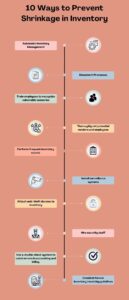23/11/2023
For businesses dealing with physical products, the recorded inventory often exceeds the actual on-hand inventory due to various reasons, collectively known as shrinkage. This discrepancy, whether caused by theft, fraud, manufacturing or shipping errors, spoilage, or other unfavorable factors, can lead to financial losses. Shrinkage not only impacts a company’s profits but may also prompt the need for price hikes to compensate, potentially affecting customer retention. In essence, shrinkage is the difference between recorded and physically available inventory, representing a loss that spans industries and supply chain processes. Whether it’s shoplifted goods, recording mistakes, or insufficient supplier deliveries, shrinkage remains a significant concern affecting businesses’ bottom lines.
What Is Shrinkage?
Consider a scenario where a grocery store records 50 notebooks of a particular type, worth 100$, only to discover 40 notebooks ($80 worth) during a physical count, with none sold. The $20 value of the 10 missing notebooks is termed as shrinkage. These unsold notebooks might have been subject to shoplifting, incorrect recording by the receiving employee, or inadequate supply from the supplier. It’s crucial to recognize that shrinkage is a significant concern in retail, extending beyond industry or supply chain sectors. Instances include material wastage during manufacturing and the spoilage of perishable items en route to a restaurant, both adversely impacting a company’s profits.
Shrinkage, sometimes known as “shrink,” is categorized as a business cost, and it is often overlooked as it accumulates gradually. Despite its seemingly small increments, it amounted to substantial losses, reaching $112.1 billion in 2022 for the retail sector alone, as reported by the National Retail Security Survey. Smaller businesses bear a more significant impact on profitability compared to larger counterparts.
Given the inevitability of some shrinkage, businesses must define an acceptable loss threshold, a variable determined by industry and individual businesses. In the retail sector, the average shrink rate in 2022 was 1.6%, according to the NRF study. However, expectations vary; for instance, a furniture manufacturer anticipates less shrinkage than a bakery, mainly due to the perishable nature of bakery products. Moreover, shrinkage tolerance differs among bakeries, with one accepting a 5% shrinkage rate while another sets a 3% cap.
Therefore, tracking shrinkage rates over time becomes crucial for businesses to establish norms. Businesses must also consider shrinkage when determining inventory orders. For instance, a furniture manufacturer fulfilling a 50-desk order may opt to order an additional 10% of mahogany to accommodate potential waste from cutting errors and wood imperfections.

Why is it Important to Address Inventory Shrinkage?
Each time inventory discrepancies arise, whether due to unknown reasons or identifiable causes, a business not only incurs the cost of the inventory itself but also forfeits potential profits from its sale. This situation may result in stockouts, leaving the business unable to meet demand and risking the loss of customers to competitors. The financial impact of shrinkage may lead a business to increase prices, potentially alienating customers. Additionally, addressing shrinkage may necessitate new expenses, such as investing in surveillance equipment and security personnel to combat shoplifting.
Prudent businesses proactively account for shrinkage in their overall costs, incorporating it into budgeting and product ordering processes to mitigate the financial impact. This strategic approach ensures businesses are adequately prepared for inventory-related challenges.
How to Calculate Inventory Shrinkage
Determining inventory shrinkage involves simply deducting the physically counted inventory from the expected amount. This calculation parallels the assessment of financial loss, where the dollar value of the counted inventory is subtracted from the documented “book value” of the inventory. For instance, if a furniture store logs a shipment of 100 new desks valued at $25,000 but only has 90 desks worth $22,500 on hand, the ten missing desks, valued at $2500, represent the shrinkage. To account for this loss, the business must create a journal entry recording the $2500 as an expense.
Expressing inventory shrinkage as a percentage offers insights into patterns and trends over time, prompting consideration of procedural changes. To calculate the percentage of shrinkage, divide the total shrinkage by total sales. In the given example, divide $2,500 by the total inventory book value ($25,000) and multiply by 100, resulting in an alarming 10% shrinkage.

Inventory Shrinkage Formula
Inventory shrinkage refers to the disparity between the recorded amount or value of inventory in a business’s accounting records (book inventory/value) and the actual amount or value in stock (actual inventory/value). The formula for computing the shrinkage value, as explained earlier, is:
Shrinkage = Inventory book value – inventory actual value
Shrinkage = $25,000 – $22,500 = $2,500
The same formula can be used to calculate inventory shrinkage for the number of units:
Shrinkage = 100 – 90 = 10 units
The formula for calculating the percentage of shrinkage — again, using the previous example — is:
Shrinkage percentage = (Shrinkage value / book value) x 100
Shrinkage percentage = ($2,500 / $25,000) x 100 = 10%
Types of Shrinkage
Shrinkage, categorized as an inventory carrying cost, poses a threat to a business’s profitability, affecting various industries and stages along the supply chain. The repercussions of shrinkage ripple through each link in the chain, leading to higher prices that are eventually borne by end customers.
Manufacturer
At the manufacturing stage, shrinkage can impede or cease production if, for instance, the manufacturer has fewer raw materials than indicated in its inventory records. The manufacturing process itself generates waste, known as spoilage, which cannot be repurposed. Shrinkage may also occur due to factors like termite damage in wood storage, posing a significant threat to manufacturers, such as the furniture manufacturer mentioned earlier.
Vendor
Consider the scenario where the furniture manufacturer fulfills an order for 50 office desks and ships them to the office furniture supplier. During transport, one desk is damaged, and another is mistakenly left behind. The supplier experiences a shrinkage of two desks. Subsequently, when fulfilling orders for 15 desks each for three companies, the supplier faces another instance of shrinkage, this time due to employee theft. This cycle repeats as shipments leave the supplier’s premises.
Retail
In the retail sector, the average shrink rate in 2022 amounted to 1.6%, equivalent to $112.1 billion, with organized crime being the primary cause, as per the 2023 NRF survey. Shoplifting and employee theft are major contributors to shrinkage, accompanied by errors in customer transactions, misuse of employee discounts, and administrative errors like pricing and inventory counting mistakes.
Causes of Shrinkage
Mitigating inventory shrinkage requires businesses to address its root causes, including:
Theft/Shoplifting: Inventory theft, whether by employees internally or customers externally, is a pervasive challenge across the supply chain. In retail, theft constitutes 65.5% of shrinkage, with internal issues like point-of-sale exceptions, where employees manipulate discounts and engage in cash theft, and return fraud, involving stolen products or counterfeit transactions for refunds.
Spoilage: Businesses in the food service industry, such as food manufacturers, restaurants, bars, and grocery stores, face shrinkage due to expiration of food and beverages. Perishable items must be disposed of if not used or sold within a limited timeframe, and obsolescence occurs when trends change, rendering inventory outdated.
Human Error/Accidents: Inevitable mistakes, from improperly packed products breaking during transit to bookkeeping errors in recording incoming inventory, cashier miscalculations, shopper-inflicted damages, or accidents like a waiter dropping a tray of food, accidents during freight shipping, contribute to shrinkage. The manual handling of tasks increases the likelihood of errors.
Vendor Inaccuracy: Vendor fraud introduces inaccuracies, whether through fraudulent vendors submitting fake invoices, legitimate vendors intentionally overbilling, or instances of double billing where an employee receives a second payment. These deceptive practices impact businesses and contribute to inventory shrinkage.

Impacts of Shrinkage
Shrinkage, a persistent, multibillion-dollar challenge, presents a variety of adverse outcomes:
Profit Loss
Shrinkage amplifies a business’s cost of goods sold (COGS) and diminishes its profit margin. Reordering inventory to compensate for losses, coupled with missed sales opportunities due to insufficient stock, further erodes the bottom line.
Escalating Expenses
The repercussions of shrinkage extend to increased business costs, notably in replacing lost inventory. Efforts to address and rectify shrinkage causes also contribute to mounting expenses. For instance, a retail store combating shoplifting may invest in additional security cameras and technology, diminishing overall profit.
Price Adjustments
Some businesses opt to raise product prices to compensate for profit lost to shrinkage, effectively passing on these costs through the supply chain. However, this strategy carries risks, as it may drive customers to seek alternatives.
Shrinkage Prevention
While complete prevention of shrinkage is unattainable in inventory-centric businesses, it is feasible to manage and mitigate its impact on profits. Implementing strategies to control shrinkage is crucial for minimizing its adverse effects.

Automate Inventory and Reporting with PALMS™ Smart WMS to Reduce Shrinkage
Shrinkage is an unavoidable aspect of business operations, but with the right solution, it can be effectively managed. PALMS™ Smart WMS safeguards a business’s profitability by offering real-time visibility into inventory across the enterprise and various points in the supply chain. Our software automates numerous inventory management processes, including tracking, tracing, replenishment, and cycle counting, ensuring enhanced accuracy compared to manual handling. PALMS™ Smart WMS plays a crucial role in minimizing shrinkage, profit loss, and customer dissatisfaction resulting from unavailability. The built-in reporting features empower managers to monitor key performance indicators, such as inventory shrinkage, lost sales ratio, and gross margin percentage.
Cumulative inventory losses can have significant consequences. Real-time inventory monitoring enables businesses to proactively address shrinkage, maintaining accurate records to prevent issues and minimize preemptive shrinkage. Understanding the causes and effects helps businesses identify appropriate strategies for shrinkage reduction. Automated inventory software plays a key role in detecting and mitigating errors related to shrinkage, providing robust protection for a business’s profits.
Shrinkage FAQs
What proportion of shrinkage results from theft?
Theft stands out as a primary contributor to industry wide shrinkage. For instance, in retail, theft accounted for 65.5% of total shrinkage in 2021, as reported by the National Retail Federation.
What constitutes acceptable levels of inventory shrinkage?
Acceptable levels of inventory shrinkage vary across industries and individual businesses. Industries like food and hospitality might tolerate a higher shrinkage rate compared to retail. However, a small coffee shop, for instance, would face more challenges recovering from shrinkage than a larger restaurant chain.
How does shrinkage impact the business?
Shrinkage directly diminishes a business’s profits and may necessitate price hikes to offset losses. It also results in additional expenses for prevention measures and may drive customers away due to elevated prices or product unavailability.
How do you define shrinkage?
Shrinkage, also known as “shrink,” denotes the loss of inventory not attributed to sales. It represents the disparity between physically available inventory and the amount recorded for accounting purposes.
What are the contributors to shrinkage?
Common causes of shrinkage encompass internal and external theft, spoilage, errors, and vendor fraud, all leading to inventory and profitability losses.
What is another term for shrinkage?
Shrinkage may also be referred to as “shrink,” “business shrinkage,” or “inventory shrinkage.”






